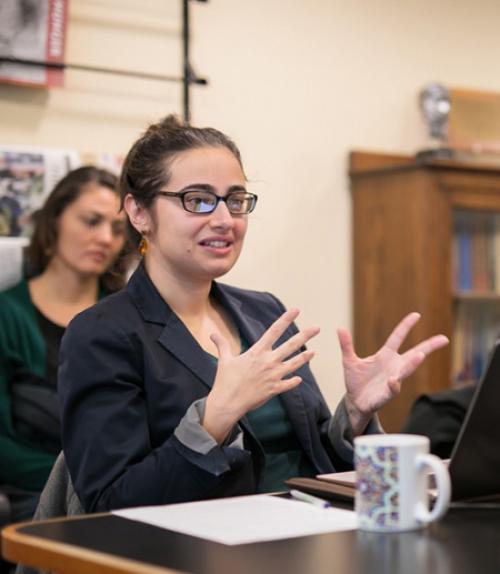The resonant strains of a Quranic recitation filled the Near Eastern Studies (NES) lounge as the students in the Listening to the Middle East course sat silent and intent. The live recitation was an impromptu demonstration by Shahzaib Saleem ’19, an NES student who had memorized the entire Quran starting in high school, and the curious students were teachers from local schools.
The NES course, a collaboration with the Tompkins-Seneca-Tioga Board of Cooperative Educational Services, gives K-12 teachers a six-session professional learning opportunity. This year’s topic is a multisensory exploration of the sounds of the Middle East.
Seema Golestaneh’s session on Nov. 27, “Islam and the Arts: Quranic Recitation Around the World,” explored the centuries-old art of Quranic recitation and the ways it is used to bring together Muslims from around the world.
“Revelation and transmission of the Quran has a long history, going back to the Prophet Mohammad who transmitted his ideas via recitation,” said Golestaneh, assistant professor of NES. “‘Quran’ actually means ‘to recite’; that’s how central the idea is.”
She explained that recitation continues to be a central part of the liturgy and pedagogy in Islam. “The recited Quran is seen as more trustworthy than what’s written down. The idea is that when it is your very own word, you wouldn’t make a mistake because it would reflect on you, whereas the written text is an object that might have fallen into the wrong hands and hence errors can creep in,” she said.
The Quran as sacred text is endlessly interpreted, Golestaneh said, and with millions of Muslims around the globe, it has been understood in myriad ways. Stylistically, recitations can vary dramatically as well.
“What does it mean to have a sacred text open to stylistic interpretation?” Golestaneh asked the class. “Religion draws from artistic or aesthetic experience, in this case music. What’s the relationship between aesthetics and religion?” She noted that Quranic recitation is not considered singing or entertainment but as its own distinct category.
In many Islamic countries, the call to prayer, a passage from the Quran, is given five times a day, Golestaneh said. “This is sonic Islam. It changes the soundscape of a city and one’s experience of that city.”
Before class, students had watched the film “Quran by Heart,” which follows three young children participating in a global recitation competition. Rama Alhabian, a Cornell graduate student helping with the class, grew up in Saudi Arabia and said she had participated in a similar competition as a girl. She gave the class a firsthand perspective on what it was like to compete. “It was very hard because of the pressure and the many hopes placed on me,” she said.
The participants came from four schools and two school districts, including Ithaca. Lexi Hartley, a teacher at Lehman Alternative Community School in Ithaca, was particularly excited about the class because she’d recently taken over teaching a course on the Modern Middle East and had never taught it before. Kara Wilcox, a social studies teacher in Dryden, enrolled in the NES course to enrich the section on world religions she offers. “I teach in a not very religiously diverse district, and the students are very curious,” she said. “They often ask excellent questions that make me think.”
The other Listening to the Middle East sessions are “Youth Music Cultures in the Middle East and North Africa,” “Iqa'at – Musical and Cultural Rhythms of the Middle East,” “Between the Rivers of Babylon, Cairo’s Cafes and Jerusalem’s Synagogues: Sounds and Memories of the Jews From Arab Countries,” “Music and Listening in Medieval Persia,” and “The Sounds of 20th Century Egyptian Weddings and Funerals: From Brass Bands to Wails and Ululations.”
This story also appeared in the Cornell Chronicle.




